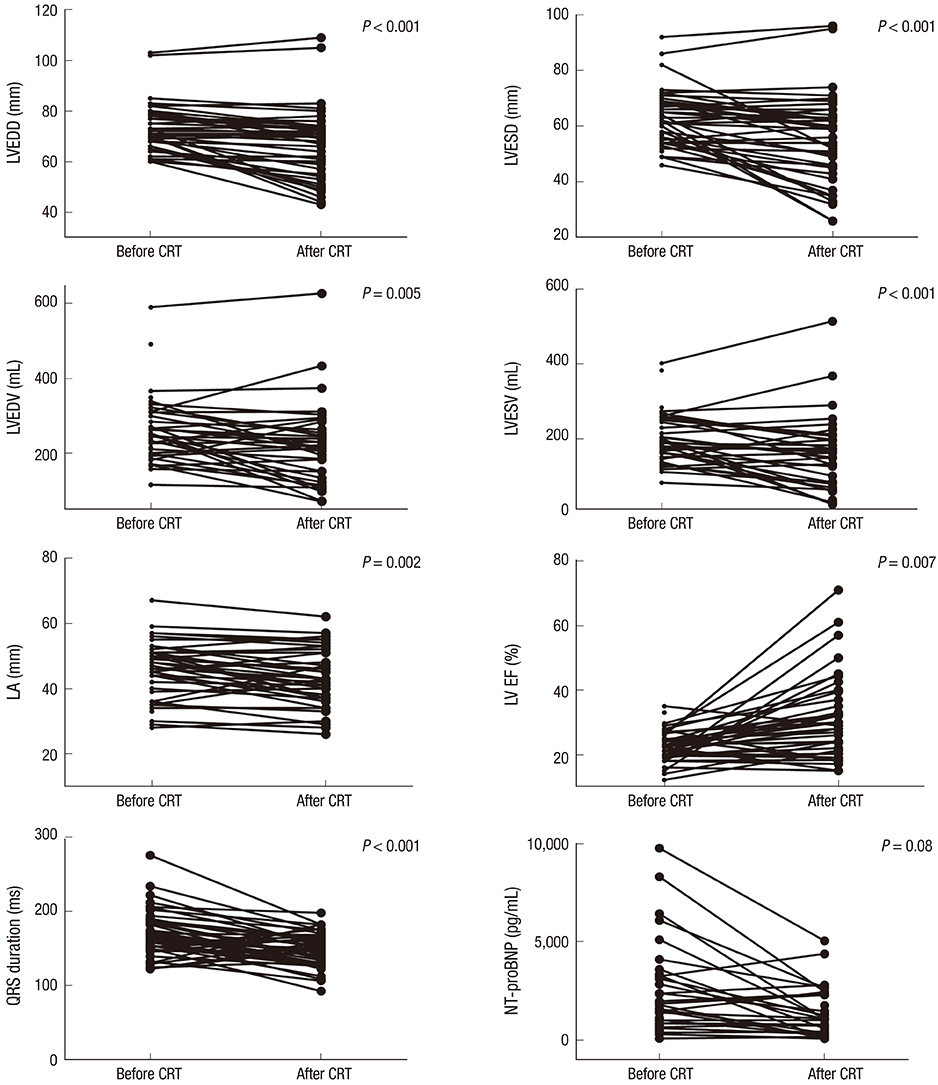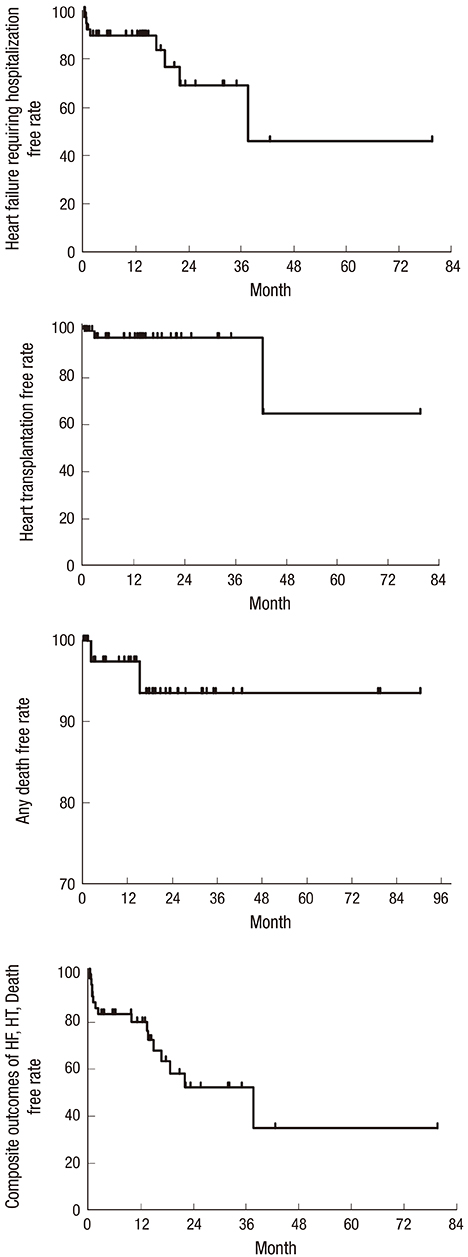Mid-Term Outcomes in Patients Implanted with Cardiac Resynchronization Therapy
- Affiliations
-
- 1Division of Cardiology, Kangbuk Samsung Medical Center, Sungkyunkwan University School of Medicine, Seoul, Korea.
- 2Division of Cardiology, Department of Medicine, Heart Vascular Stroke Institute, Samsung Medical Center, Sungkyunkwan University School of Medicine, Seoul, Korea. oykmd123@gmail.com
- 3Division of Cardiology, Gangneung Asan Hospital, University of Ulsan College of Medicine, Gangneung, Korea.
- 4Division of Cardiology, S-Jungang Hospital, Jeju, Korea.
- KMID: 2069954
- DOI: http://doi.org/10.3346/jkms.2014.29.12.1651
Abstract
- We applied cardiac resynchronization therapy (CRT) for desynchronized heart failure patients. We evaluated clinical outcomes including morbidity, mortality, and echocardiographic parameters in 47 patients with implanted CRT in Korea from October 2005 to May 2013. The combined outcomes of hospitalization from heart failure, heart transplantation and death were the primary end point. Median follow-up period was 17.5 months. The primary outcomes listed above occurred in 10 (21.3%) patients. Two patients (4.3%) died after CRT and 8 (17%) patients were hospitalized for recurrent heart failure. Among patients hospitalized for heart failure, 2 (4.3%) patients underwent heart transplantation. The overall free rate of heart failure requiring hospitalization was 90.1% (95% CI, 0.81-0.99) over one year and 69.4% (95% CI, 0.47-0.91) over 3 yr. We observed improvement of the New York Heart Association classification (3.1+/-0.5 to 1.7+/-0.4), decreases in QRS duration (169.1 to 146.9 ms), decreases in left ventricular (LV) end-diastolic (255.0 to 220.1 mL) and end-systolic (194.4 to 159.4 mL) volume and increases in LV ejection fraction (22.5% to 31.1%) at 6 months after CRT. CRT improved symptoms and echocardiographic parameters in a relatively short period, resulting in low mortality and a decrease in hospitalization due to heart failure.
MeSH Terms
-
Age Distribution
Cardiac Resynchronization Therapy/*mortality
Cardiac Resynchronization Therapy Devices/*statistics & numerical data
Female
Heart Failure/diagnosis/*mortality/*prevention & control
*Hospital Mortality
Hospitalization/*statistics & numerical data
Humans
Longitudinal Studies
Male
Middle Aged
Prevalence
Prostheses and Implants/statistics & numerical data
Recurrence
Republic of Korea/epidemiology
Risk Factors
Sex Distribution
Survival Rate
Treatment Outcome
Figure
Cited by 3 articles
-
The Past, Present and Future of Cardiac Resynchronization Therapy
Thomas O'Brien, Myung-Soo Park, Jong-Chan Youn, Eugene S. Chung
Korean Circ J. 2019;49(5):384-399. doi: 10.4070/kcj.2019.0114.Temporal Trends of Cardiac Implantable Electronic Device Implantations: a Nationwide Population-based Study
Ji Hyun Lee, So-Ryoung Lee, Eue-Keun Choi, Jaehan Jeong, Hyung-Deuk Park, So-Jeong You, Sang-Soo Lee, Seil Oh
Korean Circ J. 2019;49(9):841-852. doi: 10.4070/kcj.2018.0444.Korean Society of Heart Failure Guidelines for the Management of Heart Failure: Treatment
Jong-Chan Youn, Darae Kim, Jae Yeong Cho, Dong-Hyuk Cho, Sang Min Park, Mi-Hyang Jung, Junho Hyun, Hyun-Jai Cho, Seong-Mi Park, Jin-Oh Choi, Wook-Jin Chung, Byung-Su Yoo, Seok-Min Kang,
Korean Circ J. 2023;53(4):217-238. doi: 10.4070/kcj.2023.0047.
Reference
-
1. Epstein AE, DiMarco JP, Ellenbogen KA, Estes NA 3rd, Freedman RA, Gettes LS, Gillinov AM, Gregoratos G, Hammill SC, Hayes DL, et al. ACC/AHA/HRS 2008 Guidelines for Device-Based Therapy of Cardiac Rhythm Abnormalities: a report of the American College of Cardiology/American Heart Association Task Force on Practice Guidelines (Writing Committee to Revise the ACC/AHA/NASPE 2002 Guideline Update for Implantation of Cardiac Pacemakers and Antiarrhythmia Devices): developed in collaboration with the American Association for Thoracic Surgery and Society of Thoracic Surgeons. Circulation. 2008; 117:e350–e408.2. Abraham WT, Fisher WG, Smith AL, Delurgio DB, Leon AR, Loh E, Kocovic DZ, Packer M, Clavell AL, Hayes DL, et al. Cardiac resynchronization in chronic heart failure. N Engl J Med. 2002; 346:1845–1853.3. Bristow MR, Saxon LA, Boehmer J, Krueger S, Kass DA, De Marco T, Carson P, DiCarlo L, DeMets D, White BG, et al. Cardiac-resynchronization therapy with or without an implantable defibrillator in advanced chronic heart failure. N Engl J Med. 2004; 350:2140–2150.4. Cazeau S, Leclercq C, Lavergne T, Walker S, Varma C, Linde C, Garrigue S, Kappenberger L, Haywood GA, Santini M, et al. Effects of multisite biventricular pacing in patients with heart failure and intraventricular conduction delay. N Engl J Med. 2001; 344:873–880.5. Cleland JG, Daubert JC, Erdmann E, Freemantle N, Gras D, Kappenberger L, Tavazzi L. Cardiac Resynchronization-Heart Failure (CARE-HF) Study Investigators. The effect of cardiac resynchronization on morbidity and mortality in heart failure. N Engl J Med. 2005; 352:1539–1549.6. Surawicz B, Childers R, Deal BJ, Gettes LS, Bailey JJ, Gorgels A, Hancock EW, Josephson M, Kligfield P, Kors JA, et al. AHA/ACCF/HRS recommendations for the standardization and interpretation of the electrocardiogram: part III: intraventricular conduction disturbances: a scientific statement from the American Heart Association Electrocardiography and Arrhythmias Committee, Council on Clinical Cardiology; the American College of Cardiology Foundation; and the Heart Rhythm Society. Endorsed by the International Society for Computerized Electrocardiology. J Am Coll Cardiol. 2009; 53:976–981.7. Lang RM, Bierig M, Devereux RB, Flachskampf FA, Foster E, Pellikka PA, Picard MH, Roman MJ, Seward J, Shanewise JS, et al. Recommendations for chamber quantification: a report from the American Society of Echocardiography's Guidelines and Standards Committee and the Chamber Quantification Writing Group, developed in conjunction with the European Association of Echocardiography, a branch of the European Society of Cardiology. J Am Soc Echocardiogr. 2005; 18:1440–1463.8. Abreu CD, Xavier RM, Nascimento JS, Ribeiro AL. Long-term outcome after Cardiac Resynchronization Therapy: a nationwide database. Int J Cardiol. 2012; 155:492–493.9. Gasparini M, Lunati M, Santini M, Tritto M, Curnis A, Bocchiardo M, Vincenti A, Pistis G, Valsecchi S, Denaro A, et al. Long-term survival in patients treated with cardiac resynchronization therapy: a 3-year follow-up study from the InSync/InSync ICD Italian Registry. Pacing Clin Electrophysiol. 2006; 29:S2–S10.10. Knappe D, Pouleur AC, Shah AM, Cheng S, Uno H, Hall WJ, Bourgoun M, Foster E, Zareba W, Goldenberg I, et al. Dyssynchrony, contractile function, and response to cardiac resynchronization therapy. Circ Heart Fail. 2011; 4:433–440.11. Pitt B, Zannad F, Remme WJ, Cody R, Castaigne A, Perez A, Palensky J, Wittes J. The effect of spironolactone on morbidity and mortality in patients with severe heart failure. Randomized Aldactone Evaluation Study Investigators. N Engl J Med. 1999; 341:709–717.12. Gras D, Leclercq C, Tang AS, Bucknall C, Luttikhuis HO, Kirstein-Pedersen A. Cardiac resynchronization therapy in advanced heart failure the multicenter InSync clinical study. Eur J Heart Fail. 2002; 4:311–320.13. Likoff MJ, Chandler SL, Kay HR. Clinical determinants of mortality in chronic congestive heart failure secondary to idiopathic dilated or to ischemic cardiomyopathy. Am J Cardiol. 1987; 59:634–638.14. Adams KF Jr, Dunlap SH, Sueta CA, Clarke SW, Patterson JH, Blauwet MB, Jensen LR, Tomasko L, Koch G. Relation between gender, etiology and survival in patients with symptomatic heart failure. J Am Coll Cardiol. 1996; 28:1781–1788.15. Goldenberg I, Hall WJ, Beck CA, Moss AJ, Barsheshet A, McNitt S, Polonsky S, Brown MW, Zareba W. Reduction of the risk of recurring heart failure events with cardiac resynchronization therapy: MADIT-CRT (Multicenter Automatic Defibrillator Implantation Trial With Cardiac Resynchronization Therapy). J Am Coll Cardiol. 2011; 58:729–737.
- Full Text Links
- Actions
-
Cited
- CITED
-
- Close
- Share
- Similar articles
-
- Myocardial Dyssynchronicity and Cardiac Resynchronization Therapy
- Cardiac Resynchronization Therapy
- Implantable Cardioverter-Defibrillator and Cardiac Resynchronization Therapy
- Successful Placement of a Left Ventricular Pacing Lead Despite Coronary Sinus Dissection During Cardiac Resynchronization Therapy
- The Role of Echocardiography in Cardiac Resynchronization Therapy



